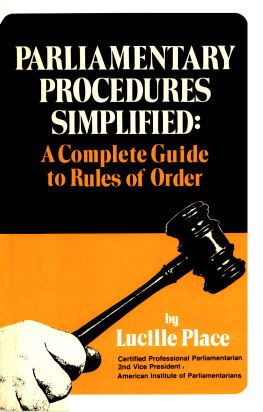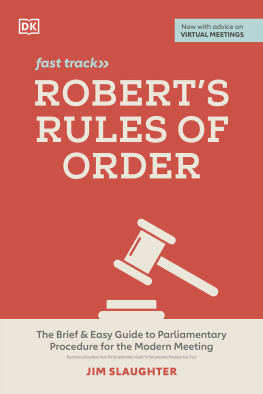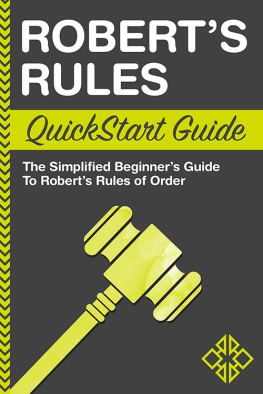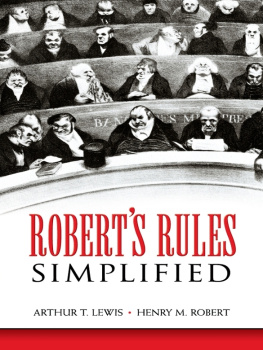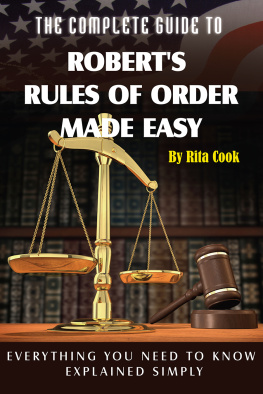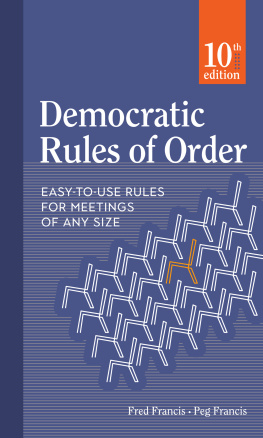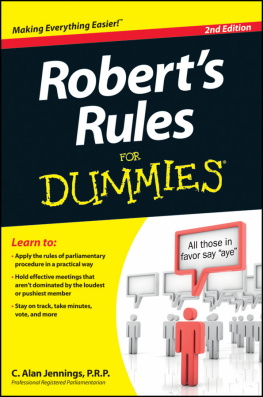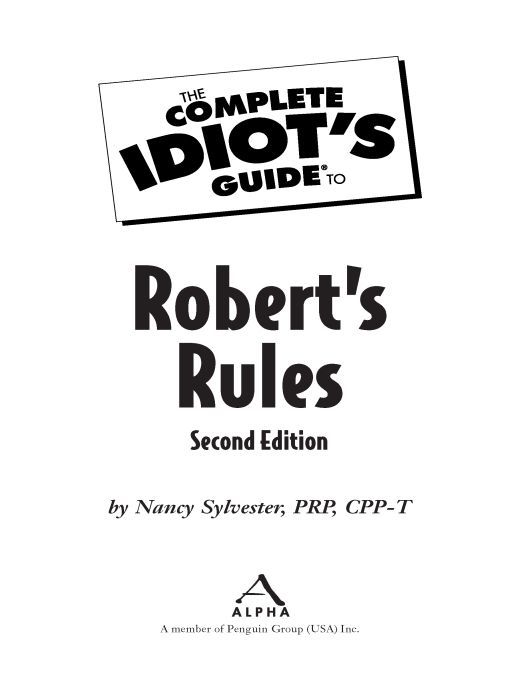Table of Contents
To my family, Jim, Marcy, and Holly, my greatest supporters; my parents, Marge and Leonard Jochim, for raising me in a family in which rules were honored; and my clients, for all you taught me.
Foreword
Congratulations on your purchase of this book. Youve already shown one thingyoure no idiot! The Complete Idiots Guide to Roberts Rules, Second Edition, is the most comprehensive guide available on meeting procedures, running effective meetings, and the world of parliamentarians.
The start of my own interest in parliamentary procedure may sound familiar. Some 20 years ago, I attended a meeting where an important proposal was being considered. I decided to say something and went to a microphone. Before I was called on, another member made a motion, it was seconded, there was a vote, and the whole matter was resolvedall before I had a chance to speak! At that instant, I decided to learn enough about meeting procedure so that would never happen again.
Unfortunately, as I tried to learn about parliamentary procedure, there wasnt a lot to help me. There were rulebooks, like Roberts Rules of Order, but most of these were overwhelming. There were books on organizing meetings, but most of these didnt even mention parliamentary procedure or how to make proposals and express views in a meeting. I dont recall any book that listed parliamentary organizations or where to go for further study.
Oh, how The Complete Idiots Guide to Roberts Rules, Second Edition, could have helped! This book has it all. Youll find information on parliamentary authorities (like Roberts Rules), tips for planning and running effective meetings, differences between board meetings and other kinds of meetings, listings of parliamentary organizations, and much more. If you need it, its in here.
To get started, just jump right in. Sure, the best idea is to read this book from start to finish, but you might not have that much time before your meeting. Whether youre pretty sure of yourself or a novice, start with Chapter 1, Chapter 2, and Chapter 4. Then, if youre new to parliamentary procedure, you may want to read Part 2. On the other hand, if you will soon have to run a meeting yourself, you may want to jump to Chapter 15 and Chapter 16. Wherever you start, youll learn valuable tips about effective meetings.
Best of luck as you start your Roberts Rules journey. Youre likely to find that knowing meeting procedure makes a big difference. Those who know the rules can get their ideas across and often quickly assume leadership positions. If youre already in a leadership role, proper procedure can help turn long, confrontational meetings into short, painless ones. As a result, you should make every effort to learn the essentials of this guide.
Time to get started! As Henry M. Robert (yes,
the Robert of
Roberts Rules) once stated:
It is difficult to find another branch of knowledge where a small amount of study produces such great results in increased efficiency in a country where the people rule, as in parliamentary law.
I couldnt have said it better!
Jim Slaughter
Jim Slaughter is the most active parliamentary consultant in the country. He is a practicing attorney, Certified Professional Parliamentarian-Teacher, and Professional Registered Parliamentarian. Jim has served as Parliamentarian to hundreds of national and state conventions, including many of the largest trade and professional associations in the country. His articles on procedure have been published in many magazines, including the American Bar Association Journal, CAIs Common Ground, and ASAEs Association Management.
Introduction
Parliamentary procedure is all about helping people run meetings efficiently, effectively, and fairly. Its important stuff for any group that wants to make sure it doesnt violate the rights of its members and that wants to get its business done as quickly and efficiently as possible.
People often mistakenly view parliamentary procedure only as a set of rules. When looked at this way, I can understand why people approach the subject with dreadfor those rulebooks are capable of curing the most severe cases of insomnia! But parliamentary procedure is so much more than a set of rules. It is a process for conducting business.
The approach I have taken in this book is to explain that process and the foundation upon which the rules are based. Then, when you find yourself without this book and you need to decide the proper way to handle the situation, you can fall back on that understanding of the process instead of trying to recall some long-forgotten rule.
My goal in writing this book was to take this very technical subject and explain it in plain English so that, at your next meeting, youll understand whats going on, what you can do, and what you cant do. To that end, Ive divided this book into five parts.
Youve probably heard the term parliamentary procedure before, but do you really know what its all about? In Part 1, Whats Parliamentary Procedure All About? Ill fill in the background information on this subject. It will help you understand the concepts that Roberts Rules are based on so that you can use your judgment instead of memorizing rules.
Motions introduce business to meetings; without them, parliamentary procedure would be meaningless. Part 2, Lets Get Moving: The Motion-Making Process, will help you move, debate, and vote on motions efficiently and fairly. It is a process that is best understood when broken down into the six easy-to-understand steps.
In Part 3, Motions for (Almost) Any Occasion, I explain approximately 25 motions. Motions are the heart of parliamentary procedure. They are the process by which a group makes a decision. You need to know about and understand these motions in order to effectively use parliamentary procedure.
Part 4, Lets Get to Order, helps you prepare for your meeting, say the right things during the meeting, and make sure you handle those all-important elections properly. The information in this part is for all members of the group, but leaders will really love it.
In Part 5, Officers, Committees, and Meetings, youll learn all about minutes and hopefully find that they are much easier to prepare than you thought. You will also learn about the responsibilities of officers and committees and the purposes of their respective reports. In addition, youll find a chapter devoted to conventions and their unique requirements and another chapter introducing you to using parliamentary procedure to run electronic meetings.
The greatest change from the first edition of this book is the appendixes. Since parliamentary procedure has its own language, I have prepared an extensive glossary, Appendix A, for your quick reference. Appendix B is a quick-glance guide to motions. If you have this in front of you at each meeting, you can find the answer to the vast majority of your questions. In Appendix C, you will find a main motion script and a board meeting agenda and script. A script is a guide to what to say when processing a motion, and you will find one for most of the motions in this book on my website, www.nancysylvester.com. I encourage you to print them out and use them during your meetings. Appendix D is full of help on minutes and forms that are included in the minutes, including the steps in preparing and a sample tellers report. Minutes are not as difficult to do as most people believe, and hopefully this appendix convinces you of that. You will find a tremendous amount of support information for the preceding information and the rest of the book on my website at www.nancysylvester.com.



